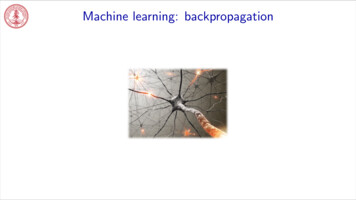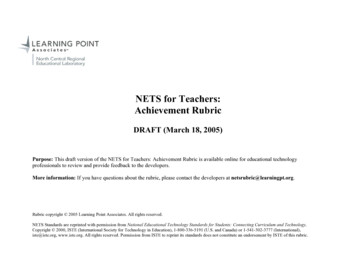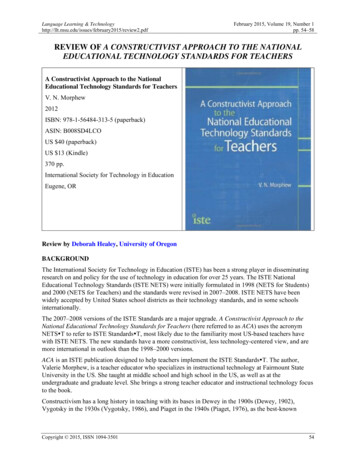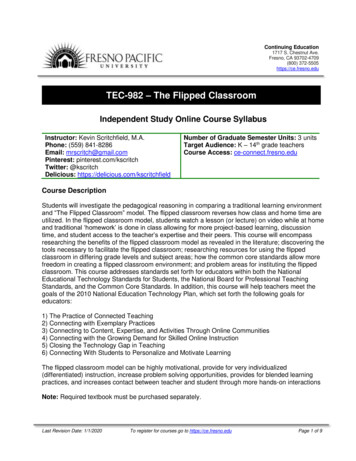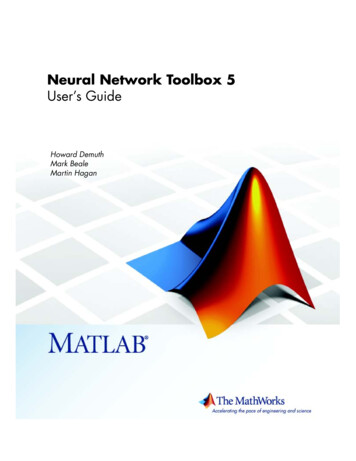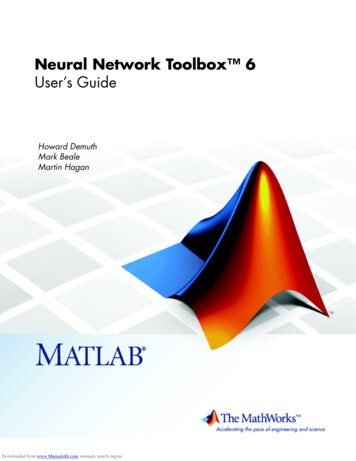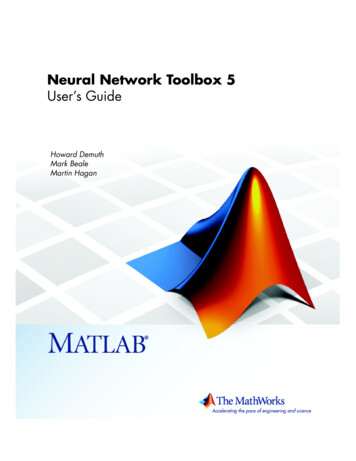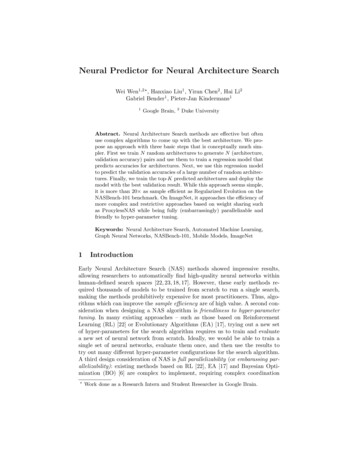
Transcription
Overfitting in Neural Nets: Backpropagation,Conjugate Gradient, and Early StoppingRich CaruanaCALD,CMU5000 Forbes Ave.Pittsburgh, PA 15213caruana@cs.cmu.eduSteve LawrenceNEC Research Institute4 Independence WayPrinceton, NJ 08540lawrence@ research. nj. nec. comLee GilesInformation SciencesPenn State UniversityUniversity Park, PA 16801giles@ist.psu.eduAbstractThe conventional wisdom is that backprop nets with excess hidden unitsgeneralize poorly. We show that nets with excess capacity generalizewell when trained with backprop and early stopping. Experiments suggest two reasons for this: 1) Overfitting can vary significantly in differentregions of the model. Excess capacity allows better fit to regions of highnon-linearity, and backprop often avoids overfitting the regions of lownon-linearity. 2) Regardless of size, nets learn task subcomponents insimilar sequence. Big nets pass through stages similar to those learnedby smaller nets. Early stopping can stop training the large net when itgeneralizes comparably to a smaller net. We also show that conjugategradient can yield worse generalization because it overfits regions of lownon-linearity when learning to fit regions of high non-linearity.1 IntroductionIt is commonly believed that large multi-layer perceptrons (MLPs) generalize poorly: netswith too much capacity overfit the training data. Restricting net capacity prevents overfitting because the net has insufficient capacity to learn models that are too complex. Thisbelief is consistent with a VC-dimension analysis of net capacity vs. generalization: themore free parameters in the net the larger the VC-dimension of the hypothesis space, andthe less likely the training sample is large enough to select a (nearly) correct hypothesis [2].Once it became feasible to train large nets on real problems, a number of MLP users notedthat the overfitting they expected from nets with excess capacity did not occur. Large netsappeared to generalize as well as smaller nets - sometimes better. The earliest reportof this that we are aware of is Martin and Pittman in 1991: "We find only marginal andinconsistent indications that constraining net capacity improves generalization" [7].We present empirical results showing that MLPs with excess capacity often do not overfit. On the contrary, we observe that large nets often generalize better than small nets ofsufficient capacity. Backprop appears to use excess capacity to better fit regions of highnon-linearity, while still fitting regions of low non-linearity smoothly. (This desirable behavior can disappear if a fast training algorithm such as conjugate gradient is used insteadof backprop.) Nets with excess capacity trained with backprop appear first to learn modelssimilar to models learned by smaller nets. If early stopping is used, training of the large netcan be halted when the large net's model is similar to models learned by smaller nets.
ApprOXlUlat l o DApproxunat lo nT rain i ng DataT urg . t Functi on 'Without Noise-xT rain i ng DataT urgel Functi on '-Vilhau! Noise -1-1Order 10Order 2015 ---------- ---------- ApprOXLnlut lon Training DataTurS. 1 Functi on '\Vi l h out N oise - 1 5 O -----------' O---------- 2010 Hidden Nodes- 1 5 O -----------' O---------- 2050 Hidden NodesFigure 1: Top: Polynomial fit to data from y sin( x /3) v . Order 20 overfits. Bottom: Small andlarge MLPs fit to same data. The large MLP does not overfit significantly more than the small MLP.2OverfittingMuch has been written about overfitting and the bias/variance tradeoff in neural nets andother machine learning models [2, 12, 4, 8, 5, 13, 6] . The top of Figure 1 illustratespolynomial overfitting. We created a training dataset by evaluating y sin( x /3) lJat 0 1 I I 2, . ,20 where lJ is a uniformly distributed random variable between -0.25 and0.25. We fit polynomial models with orders 2-20 to the data. Underfitting occurs withorder 2. The fit is good with order 10. As the order (and number of parameters) increases,however, significant overfitting (poor generalization) occurs. At order 20, the polynomialfits the training data well, but interpolates poorly.The bottom of Figure 1 shows MLPs fit to the data. We used a single hidden layer MLP,backpropagation (BP), and 100,000 stochastic updates. The learning rate was reducedlinearly to zero from an initial rate of 0.5 (reducing the learning rate improves convergence,and linear reduction performs sintilarly to other schedules [3]). This schedule and numberof updates trains the MLPs to completion. (We examine early stopping in Section 4.) Aswith polynomials, the smallest net with one hidden unit (HU) (4 weights weights) underfitsthe data. The fit is good with two HU (7 weights). Unlike polynomials, however, networkswith 10 HU (31 weights) and 50 HU (151 weights) also yield good models. MLPs withseven times as many parameters as data points trained with BP do not significantly overfitthis data. The experiments in Section 4 confirm that this bias of BP-trained MLPs towardssmooth models is not limited to the simple 2-D problem used here.3 Local OverfittingRegularization methods such as weight decay typically assume that overfitting is a globalphenomenon. But overfitting can vary significantly in different regions of a model. Figure2 shows polynomial fits for data generated from the following equation:Y {- cos( x) vcos(3(x - iT)) V0 :::; x iTiT:::;X :::;2iT(Equation 1)Five equally spaced points were generated in the first region, and 15 in the second region,so that the two regions have different data densities and different underlying functions.Overfitting is different in the two regions. In Figure 2 the order 6 model fits the left region
O roe r 2 Approxim . tio n Train ing Dat aT . r get Fu n c tio n 'Withou t No,,., Oroe r I'i Approxi m . t ion T raining D a . aT . r ge. Fu n ction 'W ithou . Noio.c 'oL--- -- -- ---- -- -- UOrder 2Oroer 10 A.t .i \,','; ''::; - . T arget Fu n c tio n 'Withou. No !o.cOrder 10Order 6Oroer ll'i t .i i:,'; ':' - . T arget Fu n c tio n ""ithoU! NoiseOrder 16Figure 2: Polynomial approximation of data from Equation 1 as the order of the model is increasedfrom 2 to 16. The overfitting behavior differs in the left and right hand regions.well, but larger models overfit it. The order 6 model underfits the region on the right, andthe order 10 model fits it better. No model performs well on both regions. Figure 3 showsMLPs trained on the same data (20,000 batch updates, learning rate linearly reduced tozero starting at 0.5). Small nets underfit. Larger nets, however, fit the entire function wellwithout significant overfitting in the left region.The ability of MLPs to fit both regions of low and high non-linearity well (without overfitting) depends on the training algorithm. Conjugate gradient (CG) is the most popularsecond order method. CG results in lower training error for this problem, but overfits significantly. Figure 4 shows results for 10 trials for BP and CG. Large BP nets generalizebetter on this problem -- even the optimal size CG net is prone to overfitting. The degreeof overfitting varies in different regions. When the net is large enough to fit the region ofhigh non-linearity, overfitting is often seen in the region of low non-linearity.4 Generalization, Network Capacity, and Early StoppingThe results in Sections 2 and 3 suggest that BP nets are less prone to overfitting thanexpected. But MLPs can and do overfit. This section examines overfitting vs. net sizeon seven problems: NETtalk [10], 7 and 12 bit parity, an inverse kinematic model for arobot arm (thanks to Sebastian Thrun for the simulator), Base 1 and Base 2: two sonarmodeling problems using data collected from a robot wondering hallways at CMU, andvision data used to learn to steer an autonomous car [9]. These problems exhibit a varietyof characteristics. Some are Boolean. Others are continuous. Some have noise. Others arenoise-free. Some have many inputs or outputs. Others have few inputs or outputs.4.1 ResultsFor each problem we used small training sets (100-1000 points, depending on the problem)so that overfitting was possible. We trained fully connected feedforward MLPs with onehidden layer whose size varied from 2 to 800 HU (about 500-100,000 parameters). All thenets were trained with BP using stochastic updates, learning rate 0.1, and momentum 0.9.We used early stopping for regularization because it doesn't interfere with backprop's ability to control capacity locally. Early stopping combined with backprop is so effective thatvery large nets can be trained without significant overfitting. Section 4.2 explains why.
-"-"'//1 Hidden Unit4 Hidden Units10 Hidden Units100 Hidden UnitsFigure 3: MLP approximation using backpropagation (BP) training of data from Equation 1 as thenumber of hidden units is increased. No significant overfitting can be seen.0707060605OJ04OJ020105::l'"Z04 OJ0201510Numbe! of Hidden Ncdes25505102550Numbei cI Hidden NodesFigure 4: Test Normalized Mean Squared Error for MLPs trained with BP (left) and CG (right).Results are shown with both box-whiskers plots and the mean plus and minus one standard deviation.Figure 5 shows generalization curves for four of the problems. Examining the results forall seven problems, we observe that on only three (Base 1, Base 2, and ALVINN), donets that are too large yield worse generalization than smaller networks, but the loss issurprisingly small. Many trials were required before statistical tests confirmed that thedifferences between the optimal size net and the largest net were significant. Moreover, theresults suggest that generalization is hurt more by using a net that is a little too small thanby using one that is far too large, i.e., it is better to make nets too large than too small.For most tasks and net sizes, we trained well beyond the point where generalization performance peaked. Because we had complete generalization curves, we noticed somethingunexpected. On some tasks, small nets overtrained considerably. The NETtalk graph inFigure 5 is a good example. Regularization (e.g., early stopping) is critical for nets of allsizes - not just ones that are too big. Nets with restricted capacity can overtrain.4.2 Why Excess Capacity Does Not HurtBP nets initialized with small weights can develop large weights only after the number ofupdates is large. Thus BP nets consider hypotheses with small weights before hypotheseswith large weights. Nets with large weights have more representational power, so simplehypotheses are explored before complex hypotheses.
NETtalkInverse Kinematics0.17 -.- - , - -.- - , - - - - ,0.2 .----.- - , - -.- - , - - - - ,2 hidden units 8 hidden units - -32 hidden units -E}-0.16128 hidden unit s .0.14 " '512hiddenunits .0.180.16*.0.15".o0.14'0jJ .r , 0.120.1; 0.130000o0 . 12 ' - - - - - ' - - - ' - - - - - ' - - - ' - - - - 'o 100000 200000 300000 400000 500000"0.08u2et06 4et06 6et06 8et06Pattern PresentationsPattern Presentations0.130.12".o . ,; 0.1100O. 222 hidden units 83282hiddenhiddenhiddenhiddenunits - -units -8- units ·K···units -A- .1et07Base 2 : Ave ra ge of 10 RunsBase 1: Average of 10 Runso. 15 r I!",,;;-.--t;--,-----.---,0.141" 0.060.210.20.1800," denhiddenunitsunitsunitsunitsunits - -·8 ···X····-A- .jJ0.1'00.09r 0.08 0.07".o . ,; o0.06o0.13u0.05 ' - - - - - ' - - - - - - ' - - - - ' - - - - '2et064et066et068et06oPattern Present ationsu0.12 ' - - - - - ' - - - - - - ' - - - - ' - - - - 'o200000400000600000800000Pattern Presentations"jJ0.17'00.16r 0.15 0.14"Figure 5: Generalization peiformance vs. net size for four of the seven test problems.We analyzed what nets of different size learn while they are trained. We compared theinput/output behavior of nets at different stages of learning on large samples of test patterns. We compare the input/output behavior of two nets by computing the squared errorbetween the predictions made by the two nets. If two nets make the same predictions forall test cases, they have learned the same model (even though each model is representeddifferently), and the squared error between the two models is zero. If two nets make different predictions for test cases, they have learned different models, and the squared errorbetween them is large. This is not the error the models make predicting the true labels, butthe difference between predictions made by two different models. Two models can havepoor generalization (large error on true labels), but have near zero error compared to eachother if they are similar models. But two models with good generalization (low error ontrue labels) must have low error compared to each other.The first graph in Figure 5 shows learning curves for nets with 10,25, 50, 100, 200, and 400HU trained on NETtalk. For each size, we saved the net from the epoch that generalizedbest on a large test set. This gives us the best model of each size found by backprop. Wethen trained a BP net with 800 HU, and after each epoch compared this net's model withthe best models saved for nets of 10-400 HU. This lets us compare the sequence of modelslearned by the 800 HU net to the best models learned by smaller nets.Figure 6 shows this comparison. The horizontal axis is the number of backprop passesapplied to the 800 HU net. The vertical axis is the error between the 800 HU net modeland the best model for each smaller net. The 800 HU net starts off distant from the goodsmaller models, then becomes similar to the good models, and then diverges from them.This is expected. What is interesting is that the 800 HU net first becomes closest to the best
S imilarity o f BOO HU Net DUring T raining to S maller Size Peak Performers1 --------,H 10 hu25hu50hu100 hu200hu400 hut .% 800tEbXx x :'""',;t:xx.!lo, ot:Xx '1:' 1600pea k .r-pea k - - pea k E}p eak )(pea k -6p eak .,.,.---- ------ ----,-400--;""':'-: li; ::::: -:: -- ----- -- -- -- - :. - - ----it- --:200o ---- ---- ----- ----- o500001000 001500002000 00Patte rn Pre s entat IOnsFigure 6: I/O similarity during training between an 800 hidden unit net and smaller nets (10, 25 , 50,100,200, and 400 hldden units) trained on NETtalk.10 HU net, then closest to the 25 HU net, then closest to the 50 HU net, etc. As it is trained,the 800 HU net learns a sequence of models similar to the models learned by smaller nets.If early stopping is used, training of the 800 HU net can be stopped when it behaves similarto the best model that could be learned with nets of 10, 25, 50, . . HU. Large BP netslearn models similar to those learned by smaller nets. If a BP net with too much capacitywould overjit, early stopping could stop training when the model was similar to a modelthat would have been learned by a smaller net of optimal size.The error between models is about 200-400, yet the generalization error is about 1600.The models are much closer to each other than any of them are to the true model. Withearly stopping, what counts is the closest approach of each model to the target function,not where models end up late in training. With early stopping there is little disadvantageto using models that are too large because their learning trajectories are similar to thosefollowed by smaller nets of more optimal size.5Related WorkOur results show that models learned by backprop are biased towards "smooth" solutions.As nets with excess capacity are trained, they first explore smoother models similar tothe models smaller nets would have learned. Weigend [11] performed an experiment thatshowed BP nets learn a problem's eigenvectors in sequence, learning the 1st eigenvectorfirst, then the 2nd, etc. His result complements our analysis of what nets of different sizeslearn: if large nets learn an eigenvector sequence similar to smaller nets, then the modelslearned by the large net will pass through intermediate stages similar to what is learned bysmall nets (but iff nets of different sizes learn the eigenvectors equally well, which is anassumption we do not need to make.)Theoretical work by [1] supports our results. Bartlett notes: "the VC-bounds seem loose;neural nets often peiform successfully with training sets that are considerably smaller thanthe number of weights." Bartlett shows (for classification) that the number of trainingsamples only needs to grow according to A 21 (ignoring log factors) to avoid overfitting,where A is a bound on the total weight magnitudes and I is the number of layers in thenetwork. This result suggests that a net with smaller weights will generalize better than asimilar net with large weights. Examining the weights from BP and CG nets shows that BPtraining typically results in smaller weights.
6 SummaryNets of all sizes overfit some problems. But generalization is surprisingly insensitive toexcess capacity if the net is trained with backprop. Because BP nets with excess capacitylearn a sequence of models functionally similar to what smaller nets learn, early stoppingcan often be used to stop training large nets when they have learned models similar to thoselearned by smaller nets of optimal size. This means there is little loss in generalizationperformance for nets with excess capacity if early stopping can be used.Overfitting is not a global phenomenon, although methods for controlling it often assumethat it is. Overfitting can vary significantly in different regions of the model. MLPs trainedwith BP use excess parameters to improve fit in regions of high non-linearity, while notsignificantly overfitting other regions. Nets trained with conjugate gradient, however, aremore sensitive to net size. BP nets appear to be better than CG nets at avoiding overfittingin regions with different degrees of non-linearity, perhaps because CG is more effectiveat learning more complex functions that overfit training data, while BP is biased towardlearning smoother functions.References[1] Peter L. Bartlett. For valid generalization the size of the weights is more important than the sizeof the network. In Advances in Neural Information Processing Systems, volume 9, page 134.The MIT Press, 1997.[2] E.B. Baum and D. Haussler. What size net gives valid generalization? Neural Computation,1(1):151- 160,1989.[3] C. Darken and J.E. Moody. Note on learning rate schedules for stochastic optimization. InAdvances in Neural Information Processing Systems, volume 3, pages 832- 838. Morgan Kaufmann, 1991.[4] S. Geman et al. Neural networks and the bias/variance dilemma. Neural Computation, 4(1):158,1992.[5] A Krogh and J.A Hertz. A simple weight decay can improve generalization. In Advances inNeural Information Processing Systems, volume 4, pages 950-957. Morgan Kaufmann, 1992.[6] Y. Le Cun, J.S. Denker, and S.A Solla. Optimal Brain Damage. In D.S. Touretzky, editor,Advances in Neural Information Processing Systems, volume 2, pages 598-605, San Mateo,1990. (Denver 1989), Morgan Kaufmann.[7] G.L. Martin and J.A Pittman. Recognizing hand-printed letters and digits using backpropagation learning. Neural Computation, 3:258-267, 1991.[8] J.E. Moody. The effective number of parameters: An analysis of generalization and regularization in nonlinear learning systems. In Advances in Neural Information Processing Systems,volume 4, pages 847-854. Morgan Kaufmann, 1992.[9] D.A Pomerleau. Alvinn: An autonomous land vehicle in a neural network. In D.S. Touretzky,editor, Advances in Neural Information Processing Systems, volume 1, pages 305-313, SanMateo, 1989. (Denver 1988), Morgan Kaufmann.[10] T. Sejnowski and C. Rosenberg. Parallel networks that learn to pronounce English text. ComplexSystems, 1:145-168, 1987.[11] A Weigend. On overfitting and the effective number of hidden units. In Proceedings of the1993 Connectionist Models Summer School, pages 335- 342. Lawrence Erlbaum Associates,1993.[12] AS. Weigend, D.E. Rumelhart, and B.A Huberman. Generalization by weight-elimination withapplication to forecasting. In Advances in Neural Information Processing Systems, volume 3,pages 875-882. Morgan Kaufmann, 1991.[13] D. Wolpert. On bias plus variance. Neural Computation, 9(6):1211-1243, 1997.
Much has been written about overfitting and the bias/variance tradeoff in neural nets and other machine learning models [2, 12, 4, 8, 5, 13, 6]. . Unlike polynomials, however, networks with 10 HU (31 weights) and 50 HU (151 weights) also yield good models. MLPs with seven times as many parameters as data points trained with BP do not .
